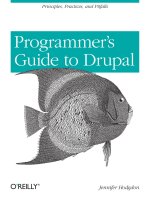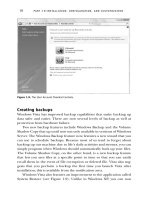Apress the programmers guide to SQL oct 2003 ISBN 1590592182
Bạn đang xem bản rút gọn của tài liệu. Xem và tải ngay bản đầy đủ của tài liệu tại đây (3.51 MB, 763 trang )
TheProgrammer'sGuidetoSQL
ISBN:1590592182
byChristianDarieandKarli
Watson
Apress©2003(400pages)
ThebookcoversthelatestversionoftheSQL
standard,SQL-99,andincludestwocomplete
casestudies,showinghowtocreateandquery
theunderlyingdatabaseforafullyfeatured
website,andhowtoimplementrole-based
securityinyourapplications.
TableofContents
TheProgrammer'sGuidetoSQL
Introduction
UnderstandingSQLandRelational
Chapter1 Databases
Chapter2 - RetrievingDatawithSQL
Chapter3 - ModifyingData
Chapter4 - SummarizingandGroupingData
PerformingCalculationsandusing
Chapter5 Functions
Chapter6 - CombiningSQLQueries
Chapter7 - QueryingMultipleTables
Chapter8 - HidingComplexSQLwithViews
Chapter9 - UsingStoredProcedures
Chapter10 - Transactions
Chapter11 - UsersandSecurity
Chapter12 - WorkingwithDatabaseObjects
Chapter13 - Triggers
Chapter14 - CaseStudy:BuildingaProductCatalog
CaseStudy:ImplementingRole-Based
Chapter15 Security
AppendixA - ExecutingSQLStatements
SettinguptheInstantUniversity
AppendixB Database
AppendixC - DataTypes
Index
ListofFigures
ListofTables
ListofExamples
ListofSidebars
BackCover
DoyouspeakSQL?Wedo,andinthisbookweprovide
youwithanin-depthyetconcisetutorialonusing
StructuredQueryLanguage(SQL),thestandardthat
defineshowtocreateandmanipulatedatabasesand
thedatatheystore.SQLisasimpleyetpowerful
language,andyou’llbeamazedathowmanythings
youcandowithjustafewlinesofcode.
Weteachyouallthebasicconceptsandprovide
practicalexamplesrelevanttoyourdailyprogramming
tasks.Onceyou’vemasteredthefundamentals,this
bookwillserveyouwellasahandyreferenceonSQL
usage.ItcoversallthemajorSQLstatementsyou’re
likelytoneedwhenprogrammingdatabasesand
providesexamplecodeforfivemajordatabase
systems:SQLServer,Oracle,DB2,MySQL,andAccess.
Ineachcase,wedemonstratehowthedatabase
systemvendorimplements,andoftenextends,the
SQLstandard.
Wefinishoffwithtwocomplete,real-worldcase
studiesthatpulltogethermanyoftheconcepts
presentedthroughoutthebook.Weshowhowto
createandquerytheunderlyingdatabaseforanecommerceapplication,aswellashowtoimplement
role-basedsecurityinyourapplications.
Whetheryou’rejuststartingoutwithSQL,working
withanunfamiliardatabase,orinneedofadesktop
reference,thisbookwillprovideyouwiththehelpand
informationyouneedtobuildeffectivedatabase
applications.
AbouttheAuthors
ChristianDarieisanindependentITconsultant
specializinginMicrosofttechnologies.Havingworked
withcomputerssincehewasachild,hewonhisfirst
prizeattheageof12inthefirstprogrammingcontest
heeverentered.Hewasactivelyinvolvedwiththe
formerWroxPressasatechnicalreviewerandauthor,
havingcontributedtheOOPpartsofVisualC#.NET:
ASP.NETE-CommercewithVisualBasic.NETand
VisualStudio.NET.HehasauthoredMCADpreparation
materialandvariousSkillDrilltests,suchasC#
programming,MicrosoftCOM+,andDB2Development.
KarliWatsonisafreelanceauthorandITspecialistwith
apenchantformulticoloredclothing.Hestartedout
withtheintentionofbecomingaworld-famous
nanotechnologist,soperhapsonedayyoumight
recognizehisnameashereceivesaNobelPrize.For
now,though,Karli’scomputinginterestsincludeall
thingsmobileandeverything.NET.Karliisalsoa
snowboardingenthusiastandwisheshehadacat.
TheProgrammer'sGuidetoSQL
CRISTIANDARIE,
KARLIWATSON
WITHCHRISHART,
KEVINHOFFMAN,
JULIANSKINNER
Copyright©2003byCristianDarie,KarliWatsonwithChrisHart,Kevin
Hoffman,JulianSkinner
Allrightsreserved.Nopartofthisworkmaybereproducedortransmitted
inanyformorbyanymeans,electronicormechanical,including
photocopying,recording,orbyanyinformationstorageorretrieval
system,withoutthepriorwrittenpermissionofthecopyrightownerand
thepublisher.
ISBN(pbk):1-59059-218-2
PrintedandboundintheUnitedStatesofAmerica10987654321
Trademarkednamesmayappearinthisbook.Ratherthanusea
trademarksymbolwitheveryoccurrenceofatrademarkedname,weuse
thenamesonlyinaneditorialfashionandtothebenefitofthetrademark
owner,withnointentionofinfringementofthetrademark.
TechnicalReviewers:CristofFalk,SlavomirFurman,BradMaiani,
JudithM.Myerson,JohanNormén,DavidSchultz
EditorialBoard:DanAppleman,CraigBerry,GaryCornell,Steven
Rycroft,JulianSkinner,MartinStreicher,JimSumser,KarenWatterson,
GavinWray,JohnZukowski
LeadEditor:TonyDavis
AssistantPublisher:GraceWong
ProjectManager:DarrenMurphy
CopyEditor:KimWimpsett
ProductionManager:KariBrooks
ProductionEditor:KellyWinquist
Proofreader:ThistleHillPublishingServices
Compositor:KineticPublishingServices,LLC
Indexer:JohnCollin
Artist:KineticPublishingServices,LLC
CoverDesigner:KurtKrames
ManufacturingManager:TomDebolski
DistributedtothebooktradeintheUnitedStatesbySpringer-VerlagNew
York,Inc.,175FifthAvenue,NewYork,NY,10010andoutsidetheUnited
StatesbySpringer-VerlagGmbH&Co.KG,Tiergartenstr.17,69112
Heidelberg,Germany.
IntheUnitedStates:phone1-800-SPRINGER,email
<>,orvisit.OutsidetheUnitedStates:fax+496221345229,email
<>,orvisit.
Forinformationontranslations,pleasecontactApressdirectlyat2560
NinthStreet,Suite219,Berkeley,CA94710.Phone510-549-5930,fax
510-549-5939,email<>,orvisit
.
Theinformationinthisbookisdistributedonan"asis"basis,without
warranty.Althougheveryprecautionhasbeentakeninthepreparationof
thiswork,neithertheauthor(s)norApressshallhaveanyliabilitytoany
personorentitywithrespecttoanylossordamagecausedorallegedto
becauseddirectlyorindirectlybytheinformationcontainedinthiswork.
Thesourcecodeforthisbookisavailabletoreadersat
intheDownloadssection.
AbouttheAuthors
CRISTIANDARIEisanindependentITconsultantspecializingin
Microsofttechnologies.Havingworkedwithcomputerssincehewasa
child,hewonhisfirstprizeattheageof12inthefirstprogramming
contestheeverentered.HewasactivelyinvolvedwiththeformerWrox
Pressasatechnicalreviewerandauthor,havingcontributedtheOOP
partsofVisualC#.NET:AGuideforVB6Developersandcoauthored
BeginningASP.NETE-CommercewithVisualBasic.NETandVisual
Studio.NET.HehasauthoredMCADpreparationmaterialandvarious
SkillDrilltests,suchasC#Programming,MicrosoftCOM+,andDB2
Development,whichcanbetakenat.
CristianisatPolitehnicaUniversityofBucharest,studyingautomatic
controlandindustrialinformatics.Hecanbecontactedthrough
.
MybigthanksgotoDave,Julian,andChrisforbeingsuchgreatpeople
toworkwith.
KARLIWATSONisafreelanceauthorandITspecialistwithapenchant
formulticoloredclothing.Hestartedoutwiththeintentionofbecominga
world-famousnanotechnologist,soperhapsonedayyoumightrecognize
hisnameashereceivesaNobelPrize.Fornow,though,Karli's
computinginterestsincludeallthingsmobileandeverything.NET.Karliis
alsoasnowboardingenthusiastandwisheshehadacat.
JULIANSKINNERstudiedGermanicetymologybeforejoiningtheformer
WroxPress.Hehasconsequentlyspentmostofthelastfour-and-a-half
yearsreading,editing,andwritingbooksaboutprogramming,focusingon
Microsofttechnologiesand,inparticular,onC#andthe.NETFramework.
Hecontributedmanysectionsandcodesamples,andoftenentire
chapters,forthebooksheworkedonatWrox,mostlyhidingbehindthe
relativeanonymityofan"additionalmaterial"credit,butheiscreditedas
acoauthorof,amongothertitles,ProfessionalADO.NET.
CHRISHARTisadeveloperandauthorbasedinBirmingham(inthe
UnitedKingdom,notAlabama).Chrisspentmostofthelastfouryearsas
amemberofthetechnicaleditorialteamattheformerWroxPressand
hasbeenprogrammingonavarietyofsystemssincetheageof10.She
spendsmostofhertimeworkingwithMicrosofttechnologiesandhas
beenheavilyinvolvedwith.NETsinceitwasfirstreleasedasanearly
alphapreview.She'scurrentlyworkingforBusinessPostandis
developing.NETCompactFramework/SQLCEapplicationsand2D
barcodescanningcomponentsinDelphi.
KEVINHOFFMANstartedprogrammingattheageof10whenhis
grandfathergavehimaCommodoreVIC-20thatherefurbished,andhe's
beenaddictedtoprogrammingeversince.Hehasworkedoneverything
fromwritinginterfacesforscientificinstrumentstobuildinge-commerce
Websitestoprovidingsecond-tiertechnicalsupportforUnix.Hegothold
of.NETwhenitwasfirsthandedoutinearlypre-betaformandhasbeen
codingwithiteversince.He'scurrentlyemployedinHouston,Texas,
wherehecreatesenterpriseapplicationswiththe.NETFrameworkfora
financialservicescompany.
Introduction
Structuredquerylanguage(SQL)isthelanguageofthedatabase.It'sa
standardthatdefineshowtomanipulatealmosteveryaspectof
database,fromcreatingthedatabaseandtablesthemselvestocreating,
reading,inserting,updating,anddeletingdatainthedatabase.This
standardisthenimplementedandextendeddifferentlybyeachdatabase
systemvendor.
ThecurrentversionoftheSQLstandardisSQL-99.Mostmajordatabase
platformsnowadherefairlycloselytothisstandardwithacoupleof
exceptions.MicrosoftAccess,forexample,hasonlyrecently(with
AccessXP)adoptedtheSQL-92standard.PreviouseditionsofAccess
supportedonlySQL-89.
Inthisbook,we'llwalkthroughallthemajorSQLstatementsyou'relikely
toneedwhenprogrammingdatabases.We'llhighlightdifferences
betweenthestandardandimplementationsusedinfivemajordatabase
systems:
SQLServer
Oracle
DB2
MySQL
Access
WhoisthisBookFor?
ThisbookisdesignedtomeettheneedsofboththenoviceSQL
programmerwhoneedsabitofsyntacticalhelpandthedeveloperusing
SQLdaytodaywhoneedsahandydesktopSQLreference.Youdon't
needtohavedonemuchdatabaseprogrammingbefore,butsome
experiencewithdatabaseswillbeuseful.Youshouldalsohaveoneof
thefivedatabasesystemsmentionedearliertogainthemostbenefits
fromthisbook.
WhatDoesthisBookCover?
Thisbookcoversthefollowingtopics:
Chapter1,"UnderstandingSQLandRelationalDatabases":
Introducesandclarifieskeyconceptsyou'llusethroughoutthe
book.Thischapteralsolooksatrelationaldatabasedesign
theory.
Chapter2,"RetrievingDatawithSQL":Discussestheuseof
simpleSELECTstatementstoretrievedatafromatable.
Chapter3,"ModifyingData":Coversmodifyingdatainatable
usingINSERTandUPDATEstatements.
Chapter4,"SummarizingandGroupingData":Showshowto
usesomebuilt-infunctionsforcountingrowsandaveraging
columnsandthenmovesontolookattheGROUPBYand
HAVINGstatements.Thischapteralsohighlightsdifferences
betweenplatformswhenitcomestodisplayingselectedrows.
Chapter5,"PerformingCalculationsandUsingFunctions":
Describesmanymoreavailablefunctionsthatcanbeusedfor
performingcalculations,manipulatingstrings,workingwithdates
andtimes,andsoon.Italsocoverscreatingyourownfunctions.
Chapter6,"CombiningSQLQueries":Talksaboutsubqueries
andhowtorefinequeriesbycombiningdatafromdifferent
queries.
Chapter7,"QueryingMultipleTables":Introducesjoins
betweentablesandusingthebuilt-inrelationshipsdefinedinthe
databasetopresentthecorrectresultswhenbuildingupaquery.
Chapter8,"HidingComplexSQLwithViews":Discusses
creatingviewsforstoringqueries.Italsodiscusseshowyoucan
useviewstograntrestrictedaccesstodatatouserswithout
havingtoworryaboutthemharmingtheunderlyingdata.
Chapter9,"UsingStoredProcedures":Showshowtocreate
andworkwithstoredproceduresoneachofthesupporting
databaseplatforms.Italsoshowshowtouseconditional
execution,loops,andcursors,andhowtohandleerrors.
Chapter10,"Transactions":Coversthetopicoftransactions
andhowthey'reimplementedondifferentplatformstohandle
updatestoadatabase.Thischapteralsocoversdifferentlocking
methodsthatcanbeappliedtodatawhileatransactionis
processed.
Chapter11,"UsersandSecurity":Discussesthekeyconcepts
ofuserauthenticationandauthorization,focusingontheuseof
rolesandpermissionstorestrictorenablecertaindatabase
functionality.
Chapter12,"WorkingwithDatabaseObjects":Discusseshow
tocreate(anddelete)databases,tables,temporarytables,
sequences,andindexesandhowtoapplyconstraintstocolumns
inatable.
Chapter13,"Triggers":Discusseshowtocreateanduse
triggerstoreacttoeventsindatabases;forexample,theinsertion
ofaroworthedeletionofatable.
Chapter14,"CaseStudy:BuildingaProductCatalog":
Drawingonmuchoftheknowledgegainedthroughouttherestof
thebook,thiscasestudydemonstrateshowtocreateandquery
theunderlyingdatabaseforareale-commerceapplication
Chapter15,"CaseStudy:ImplementingRole-Based
Security":ExamineshowtouseSQLandstoredproceduresto
implementarole-basedsecuritysystem.
Alsointhisbookarethreeappendixesthatcoverthefollowing:
AppendixA,"ExecutingSQLStatements":Providesan
overviewofhowtogetupandrunningsothatyou'rereadyto
startexecutingSQLstatementsagainsteachofthedatabase
platforms.
AppendixB,"SettingUptheInstantUniversityDatabase":
DescribeshowtocreateandpopulatetheInstantUniversity
sampledatabasethat'susedthroughouttheexamplesinthis
book.
AppendixC,"DataTypes":Liststhedifferentdatatypes
availabletoSQLprogrammersoneachofthedifferentdatabase
platforms.
WhatYouNeedtoUsethisBook
Torunthecodeinthisbook,you'llneedtohaveoneofthefollowing
databaseplatformsinstalledonacompatibleoperatingsystem:
SQLServer
Oracle
DB2UDB
MySQL
Access
AlltheSQLcodeinthebookhasbeentestedagainsteachofthese
systems.Specifically,theversionsweusedtotestthecodewereas
follows:
SQLServer2000
Oracle9iR2
DB28.1beta
MySQL4.0gamma
Access2000
CustomerSupportandFeedback
Wealwaysvaluehearingfromourreaders,andwewanttoknowwhat
youthinkaboutthisbook:whatyouliked,whatyoudidn'tlike,andwhat
youthinkwecandobetternexttime.
HowtoTellusExactlyWhatYouThink
Youmightjustwanttotellushowmuchyoulikedorloathedthebookin
question.Oryoumighthaveideasabouthowthiswholeprocesscould
beimproved.Ineithercase,youshoulde-mail
<>.Pleasebesuretomentionthebook'sISBN
andtitleinyourmessage.You'llalwaysfindasympatheticear,nomatter
whattheproblemis.Aboveallyoushouldrememberthatwedocare
aboutwhatyouhavetosay,andwewilldoourutmosttoactuponit.
WhatWeCan'tAnswer
Obviouslywithanever-growingrangeofbooksandanever-changing
technologybase,there'sanincreasingvolumeofdatarequiringsupport.
Althoughweendeavortoanswerallquestionsaboutthebook,wecan't
solvebugsinyourownprogramsthatyou'veadaptedfromourcode.
However,dotellusifyou'reespeciallypleasedwiththeroutineyou
developedwithourhelp.
DownloadingtheSourceCodefortheBook
Thesourcecodeforthisbookisavailabletoreadersat
intheDownloadssection.
FindingSupportandErrataonwww.apress.com
Weunderstandthaterrorscandestroytheenjoymentofabookandcan
causemanywastedandfrustratedhours,soweseektominimizethe
distresstheycancause.Thefollowingsectionswillexplainhowtofind
andposterrataonourWebsitetogetbook-specifichelp.
FindingErrata
Beforeyousendinaquery,youmightbeabletosavetimebyfindingthe
answertoyourproblemonourWebsiteat.
Locatethisbookintheonlinecatalogorwithinthebook'scategoryand
gotothebook'sWebpage.ChecktoseeifthereisaCorrectionslink.If
thereis,clickthelinktoseethepostederrata.
AddinganErratumtotheWebSite
Ifyouwanttopointoutanerratumordirectlyqueryaprobleminthe
book,thenclicktheSubmitErratalinkonthebook'sWebpage.Please
besuretoincludeyournameande-mailandthechapternumber,page
number,andabriefdescriptionoftheproblem,asrequested.
Wewon'tsendyoujunkmail.Weneedthedetailstosaveyourtimeand
ours.
Querieswillbeforwardedtothebook'sauthorsandeditor.Youmay
receiveadirecte-mailreply,and/ortheerratumwillbepostedtotheWeb
sitesoallreaderscanbenefit.
ParticipatinginPeer-to-PeerForums
Forauthorandpeerdiscussion,jointheApressdiscussiongroups.Ifyou
postaquerytoourforums,youcanbeconfidentthatmanyApress
authors,editors,andindustryexpertsareexaminingit.At
forums.apress.comyou'llfindanumberofdifferentliststhatwillhelp
you,notonlywhileyoureadthisbookbutalsoasyoudevelopyourown
applications.TosignupfortheApressforums,goto
forums.apress.comandselecttheNewUserlink.
Chapter1:UnderstandingSQLandRelational
Databases
Attheheartofalmosteverylarge-scaleapplication,whetheritbeaWeb
applicationoracorporateintranet,isthedatabase.Themodern
databasehasmovedonalongwayfromtheflat-fileaddress-cardstyleof
databasestorage,andyounowhavetheabilitytostoreterabytesof
informationaboutcustomers,products,contacts,andsoon.It'sallvery
wellstoringallofthisdatainacentraldatabase,butsimplystoringdata
doesn'tgiveyoumuchinreturnifyoucan'tfindsomewaytoorganize,
access,andworkwiththisdata.StructuredQueryLanguage(SQL)isa
standardizedlanguagedesignedtoaccessandmanipulatedatastoredin
relationaldatabasesandtoworkwiththedatabasesthemselves.
ThischapterexplainswhatSQLisandhowitworks.You'llalsobe
lookingatsomerelationaldatabasetheorybecausetobeabletowork
confidentlywithSQL,youneedtounderstandsomeofthesecore
concepts.
WhatisSQL?
SQLisalanguagethat'susedforaccessingandmanipulatingdatabases
and,moreimportantlyfortheprogrammer,thedatathat'scontainedin
databases.SQLstatementsgiveyouthepowertomanipulateallaspects
ofyourdatabaseusingcodeinsteadofvisualtools.
Note SQLispronouncedeither"ess-kue-ell"or"see-kwell"
dependingonyourpreference.Wegoforthelatter,sono
complaintsaboutuswriting"aSQLstatement"ratherthan"an
SQLstatement,"please!
Inessence,whatyouhaveisa"frontend"thatsendsaSQLstatement
(orasetofSQLstatements)toa"back-end"datastore.Fora
programmer,thisSQLstatementwillmostcommonlycontaincoded
instructionstoperformoneormoreofthefollowingoperations:
Extractingspecificdatafromthedatabase
Insertingnewdataintothedatabase
Modifyingexistingdata
Deletingdata
Manycommercialvendorssupplyrelationaldatabases,including
Microsoft(SQLServerandAccess),OracleCorporation(Oracle),and
IBM(DB2).Therearealsoseveralfreelyavailableopen-sourceproducts
suchasMySQLandPostgresSQL.Nomatterwhatplatformyou'reusing,
severalfeaturesarecommontoallrelationaldatabases,whateverthey
contain.Alldatainthesedatabasesisheldinrows(alsoknownas
records)thatspanthecolumns(fields)ofatablewithinthedatabase,and
thevaluesforeachcolumnareofaspecifieddatatype.Becausethe
dataisstoredinasimilarstructureondifferentplatforms,youcanuse
similartechniquestoaccessandmanipulatethedata.Furthermore,each
oftheseplatformsusesSQLastheuniversallanguagetoimplement
thesetechniques.Inotherwords,SQListhelanguagethatevery
relationaldatabaseunderstands.
Whataboutyour"frontend"?Well,youhaveavarietyofoptionshere,
too.Forexample,yourfrontendmightbeoneofthefollowing:
AWebpagethatallowsacustomertoenterinformationintoa
Searchbox.Basedonthedataentered,aSQLstatementwillbe
constructed,senttotheback-enddatastore,andexecuted,and
thespecificdatathatthecustomerrequestedwillbereturnedand
displayedontheWebpage.
Abusinessapplicationthatallowsemployeestoqueryadata
storeforinformationaboutemployees,productsales,orany
numberofthings.
AsimpleSQLeditingtool,asprovidedbyeveryrelational
databaseproduct,thatallowsyoutoexecuteSQLstatements
againstadatabaseonyourowncomputeroracomputertowhich
you'renetworked.
AndhereyouhavetherealbeautyofSQL:Regardlessofthelanguage
usedtocreatethefrontend—beitASP.NET,Java,VisualBasic,C#,or
virtuallyanyotherlanguage—SQListhelanguagethatallofthesefront
endswillusetocommunicatewitharelationaldatabase.
Inadditiontoallthis,youcanalsouseSQLtoadministertherelational
databaseitself—forexample,tocreateorremovenewdatabasestorage
structuresortoaccessandmodifythesecuritysettingsforthatdatabase.
Thebottomlineisthatregardlessofthelanguageinwhichyouprogram
ortheparticulardatabaseinwhichyoustoreyourdata,knowledgeof
SQLisanessentialskill.
IntroducingtheSQLStandard
SQLhasquitealonghistory.ItwasfirstinventedatIBMin1974–75and
wasusedtocommunicatewithmainframedatabases.Later,in1979,the
firstcommercialrelationaldatabaseproductthatsupportedSQLwas
releasedbyOracle,andin1986–87theANSIandISOstandards
organizationsworkedonaSQLstandardthatwasreleasedtwoyears
later,knownasSQL-89.Thisstandardwasupdatedin1991toanew
version,SQL-92,andsubsequentlytoanotherversion,SQL-99(also
referredtoasSQL:1999andSQL3).Thisbookconcentratesonthis
SQL-99standard.
Thestandarddefinestechniquesforavarietyofoperationsonrelational
databasesandthedatathattheycontain.Essentially,theSQLstandard
splitsdownintothreekeycomponents:
DataManipulationLanguage(DML):Thisisthecomponentof
thelanguagewithwhichthisbookismostconcerned.Itprovides
fourbasicSQLstatements:
SELECTstatementsthatareusedtoreadandextract
datafromthedatabase.Thisportionofthelanguageis
oftengivenasubheadingallitsown,namelyDataQuery
Language(DQL);theseSQLstatementscancorrectlybe
referredtoasSQLqueries.
INSERTstatementsthatareusedtoinsertnewrowsof
dataintothedatabase.
UPDATEstatementsthatareusedtomodifyexistingrows
ofdata.
DELETEstatementsthatareusedtoremoverowsofdata
fromthedatabase.
DataDefinitionLanguage(DDL):Thisisusedtocreate,modify,
orremovetablesandotherdatabaseobjects.Itincludessuch
statementsasCREATETABLE,ALTERTABLE,DROPTABLE,
CREATEINDEX,andsoon.You'llinvestigatethiscomponentof
thelanguageinChapter12,"WorkingwithDatabaseObjects."
DataControlLanguage(DCL):Thisisusedtomanage
databasesecurity,managewhichusershaveaccesstowhich
tablesandwhatdata,andsoon.You'llinvestigatethisinChapter
11,"UsersandSecurity."
ThemajorityofthisbookisdevotedtotheDMLcomponentofSQLand
morespecificallytowritingSQLqueries.
HowSQLWorks
Asitsnamesuggests,alargepartoftheStructuredQueryLanguageis
dedicatedtotheprocessofqueryingarelationaldatabase.Thatis,you
canuseSQLtoaskcertain"questions"ofthedatabaseandhavethe
"answer"(aroworrowsofdata)returned.Forexample,sayyouhavea
databasethatstoresinformationaboutaparticularuniversityandthe
coursesitruns,thepeoplewhoteachthosecourses,andsoon.You
mightaskthequestion"Whichcoursesareofferedbytheuniversity?"A
SQLquerysuchasthefollowingmightdothetrick:
SELECT*FROMCourses
Whatthisqueryisbasicallysayingindatabase-speakis"Givemealistof
alloftheinformationstoredforallofthecoursesintheCoursestable."
Thisquerywouldworkagainstanyrelationaldatabaseaslongasit
containedaCoursestable.Now,theCoursestablemightholda
varietyofdifferentinformation,andperhapsyou'reonlyinterestedinthe
nameofthecoursesoffered.ThenyoumightmodifyyourSQLqueryas
follows:
SELECTCourseNameFROMCourses
Now,thisquerywouldworkagainstanyrelationaldatabaseaslongasit
hadaCoursestablethatcontainedacolumncalledCourseName.
Whatit'ssayingis"Givemeonlythenamesofallthecoursesinthe
Coursestable."Inotherwords,giveyoualltherowsstoredinthe
databasebutonlyreturnthevaluesstoredintheCourseNamecolumn.
Anyotherinformationstoredinthetable,suchasthenumberofcredits
requiredtopasseachcourse(perhapsstoredinaCreditscolumn)
wouldbeignored.Finally,supposeyouwantedtoseedatafromallofthe
columnsintheCoursestablebutonlyforChemistrycourses:
SELECT*FROMCoursesWHERECourseName='Chemistry'
Wewon'tgoanyfurthernow,butwehopeyoucanseethat,insome
circumstances,alineofSQLcanoftenlookmuchthesameasalineof
English.Ofcourse,there'sabitmoretoitthanthat,andcomplex
operationswillrequirefarmorecomplexSQLcode!Likeanylanguage,
youhavealotofsyntaxandusageinformationtolearn,butSQLdoes
haveoneimportantadvantage:Onceyougetusedtoit,thesyntaxis
simpleindeedandcanoftenbeinterpretedevenbypeoplewhohave
neverseenitbefore.
OneimportantpointtotakehomefromthisdiscussionisthatyourSQL
statementsmerelydefinewhichdatayouwanttoretrieve.Youdon't
specifyhowyourdatabaseshouldgoaboutretrievingthem.SQLisa
declarativelanguage,notaprocedurallanguage(suchasJava,Visual
Basic,andsoon).YoujustspecifywhatyouwanttodoinSQLandlet
yourRelationalDatabaseManagementSystem(RDBMS)decidethe
bestwaytoactuallydoit.
IntroducingRelationalDatabaseManagementSystems
Thetermdatabaseisoftenconfusedwith"thesoftwarethatmakesdata
storagepossible."Forexample,you'veprobablyheardSQLServer,
Access,andOraclereferredtoasdatabases.Moreaccurately,they
shouldbereferredtoasRelationalDatabaseManagementSystems
(RDBMSs).They'reapplicationsthatareresponsibleforthestorageof
dataaswellasprovidinganinterfacethatcanbeusedtoaccessthe
database(s)theycontain.Typically,aswellassomekindofuser
interface,RDBMSsincludeanApplicationProgrammingInterface(API)
thatcanbeusedbyotherapplicationstoaccessdata.
EachRDBMSwillbecapableofmaintainingalargenumberofindividual
databases(inotherwords,thedatastorageconstructsandtheactual
data).
OnecrucialpartofRDBMSsisthedatabaseengine.Thispartofan
RDBMSisresponsibleforaccessingdata,asopposedtootherpartsthat
mayrelatetomanipulatingdatabasemanipulationmoreabstractly,
dealingwithuserinput,displayingresults,andsoon.Assuch,whenyou
programmaticallyaccessdatabasesstoredbyRDBMSs,you'rereally









